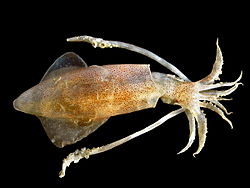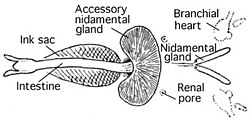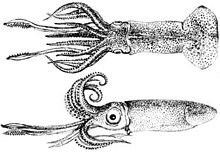This is an old revision of this page, as edited by Sluzzelin (talk | contribs) at 17:34, 11 March 2007 (rv silliness to last version 05:20, 9 March 2007 by Sengkang). The present address (URL) is a permanent link to this revision, which may differ significantly from the current revision.
Revision as of 17:34, 11 March 2007 by Sluzzelin (talk | contribs) (rv silliness to last version 05:20, 9 March 2007 by Sengkang)(diff) ← Previous revision | Latest revision (diff) | Newer revision → (diff) For other uses, see Squid (disambiguation).
| Squid | |
|---|---|

| |
| Mastigoteuthis flammea A species of whip-lash squid | |
| Scientific classification | |
| Kingdom: | Animalia |
| Phylum: | Mollusca |
| Class: | Cephalopoda |
| Subclass: | Coleoidea |
| Superorder: | Decapodiformes |
| Order: | Teuthida A. Naef, 1916b |
| Suborders | |
Squid are a large, diverse group of marine cephalopods. Like all cephalopods, squid are distinguished by having a distinct head, bilateral symmetry, a mantle, and arms. Squid, like cuttlefish, have eight arms and two tentacles arranged in pairs.
Modification from ancestral forms
Squid have differentiated from their ancestral molluscs in such a way that the body plan has been condensed antero-posteriorly and extended dorso-ventrally. What before may have been the foot of the ancestor is now modified into a complex set of tentacles and highly developed sense organs, including advanced eyes similar to those of vertebrates.
The shell of the ancestor has been lost, with only an internal gladius, or pen, remaining.
Anatomy

The main body mass of the squid is enclosed in the mantle, which has two swimming fins along each side. It should be noted that these fins, unlike in other marine organisms, are not the main source of ambulation. The skin of the squid is covered in chromatophores, which enable the squid to change color to suit its surroundings. The underside of the squid is also found to be lighter than the topside, in order to provide camouflage from both prey and predator.
Under the body are openings to the mantle cavity, which contains the gills (ctenidia) and openings to the excretory and reproductive systems. At the front of the mantle cavity lies the siphon, which the squid uses for locomotion via precise jet propulsion. This is done by sucking water into the mantle cavity and quickly expelling it out of the siphon in a fast, strong jet. The direction of the siphon can be changed in order to suit the direction of travel.
Inside the mantle cavity, beyond the siphon, lies the visceral mass of the squid, which is covered in a thin, membranous epidermis. Under this are all the major internal organs of the squid.
Reproductive system

In female squid, the ink sac is hidden from view by a pair of white nidamental glands, which lie anterior to the gills. There are also red-spotted accessory nidamental glands. Both of these organs are associated with manufacture of food supplies and shells for the eggs. Females also have a large translucent ovary, situated towards the posterior of the visceral mass.
Male squid do not possess these organs, but instead have a large testis in place of the ovary, and a spermatophoric gland and sac. In mature males, this sac may contain spermatophores, which are placed inside the mantle of the female during mating.
Digestive system
Squid, like all cephalopods, have a complex digestive system. Food is transported into a muscular stomach, found roughly midpoint in the visceral mass. The bolus is then transported into the caecum for digestion. The caecum, a long, white organ is found next to ovary or testis. In mature squid, more priority is given to reproduction and so the stomach and caecum often shrivel up towards the later stages of life. Finally, food goes to the liver (or digestive gland), found at the siphon end of the squid, for absorption. Solid waste is passed out of the rectum. Beside the rectum is the ink sac, which allows a squid to discharge a black ink into the mantle cavity at short notice.
Cardiovascular system
Squid have three hearts. Two brachial hearts, feeding the gills, each surrounding the larger systemic heart that pumps blood around the body. The hearts have a faint greenish appearance and are surrounded by the renal sacs - the main excretory system of the squid. The kidneys are faint and difficult to identify and stretch from the hearts (located at the posterior side of the ink sac) to the liver. The systemic heart is made of three chambers, a lower ventricle and two upper auricles.
Head
The head end of the squid bears 8 arms and two tentacles, each a form of muscular hydrostat containing many suckers along the edge. These tentacles do not grow back if severed. In mature male squid, one basal half of the left ventral tentacle is hectocotylised - it ends in a copulatory pad rather than suckers. This is used for intercourse between mature males and females.
The mouth of the squid is equipped with a sharp horny beak made of chitin, used to kill and tear prey into manageable pieces. Captured whales often have squid beaks in their stomachs, the beak being the only indigestible part of the squid. The mouth contains the radula (the rough tongue common to all molluscs except bivalvia and aplacophora).
The eyes of the squid, found on either side of the head, contains a hard lens, which is used much like the lens of a binocular for focusing; rather than changing shape, like a human eye, it moves mechanically.

Size
See also: Giant squid, Colossal Squid, and Cephalopod sizeThe majority of squid are no more than 60 cm long, although the giant squid may reach 13 m in length. In 2003 a large specimen of an abundant but poorly understood species, Mesonychoteuthis hamiltoni (the Colossal Squid) was discovered. This species may grow to 14 m in length, making it the largest invertebrate. It also possesses the largest eyes in the animal kingdom. Giant squids are featured in literature and folklore, with a frightening connotation. The Kraken is a legendary tentacled monster possibly based on sightings of real giant squids.
A Colossal Squid, weighing an estimated 992 lbs and about 39 feet long, was caught by a New Zealand fishing vessel off the coast of Antarctica in February 2007.
Classification



Squid are members of the class Cephalopoda, subclass Coleoidea, order Teuthida, of which there are two major suborders, Myopsina and Oegopsina (including the giant squids like Architeuthis dux). Teuthida is the largest of the cephalopod orders, edging out the octopuses (order Octopoda) for total number of species, with 298 classified into 28 families.
The order Teuthida is a member of the superorder Decapodiformes (from the Greek for "ten legs"). Two other orders of decapodiform cephalopods are also called squid, although they are taxonomically distinct from Teuthida and differ recognizably in their gross anatomical features. They are the bobtail squid of order Sepiolida and the Ram's Horn Squid of the single species order Spirulida. The Vampire Squid, however, is more closely related to the octopuses than to any of the squid.
- CLASS CEPHALOPODA
- Subclass Nautiloidea: nautilus
- Subclass Coleoidea: squid, octopus, cuttlefish
- Superorder Octopodiformes
- Superorder Decapodiformes
- ?Order †Boletzkyida
- Order Spirulida: Ram's Horn Squid
- Order Sepiida: cuttlefish
- Order Sepiolida: bobtail squid
- Order Teuthida: squid
- Suborder Myopsina
- Family Australiteuthidae
- Family Loliginidae: inshore, calamari, and grass squid
- Suborder Oegopsina
- Family Ancistrocheiridae: Sharpear Enope Squid
- Family Architeuthidae: giant squid
- Family Bathyteuthidae
- Family Batoteuthidae: Bush-club Squid
- Family Brachioteuthidae
- Family Chiroteuthidae
- Family Chtenopterygidae: comb-finned squid
- Family Cranchiidae: glass squid
- Family Cycloteuthidae
- Family Enoploteuthidae
- Family Gonatidae: armhook squid
- Family Histioteuthidae: jewel squid
- Family Joubiniteuthidae: Joubin's Squid
- Family Lepidoteuthidae: Grimaldi Scaled Squid
- Family Lycoteuthidae
- Family Magnapinnidae: bigfin squid
- Family Mastigoteuthidae: whip-lash squid
- Family Neoteuthidae
- Family Octopoteuthidae
- Family Ommastrephidae: flying squid
- Family Onychoteuthidae: hooked squid
- Family Pholidoteuthidae
- Family Promachoteuthidae
- Family Psychroteuthidae: Glacial Squid
- Family Pyroteuthidae: fire squid
- Family Thysanoteuthidae: rhomboid squid
- Family Walvisteuthidae
- Parateuthis tunicata (incertae sedis)
- Suborder Myopsina
As food
Many species of squid are popular as food in cuisines as widely separated as Korean and Italian. In English-speaking countries, it is often known by the name calamari. Individual species of squid are found abundantly in certain areas and provide large catches for fisheries. The body can be stuffed whole, cut into flat pieces or sliced into rings. The tentacles and ink are also edible; in fact, the only part of the squid that is not eaten is its beak and gladius (pen).
There are many ways in which squid is eaten worldwide.
- In Italy and Greece, squid rings and tentacles are often coated in batter and fried in oil. Other recipes from these regions feature squid (or octopus) simmered slowly, often with tomatoes. When frying, the squid flesh is kept tender by keeping the cooking time as short as possible. When simmering, the flesh is most tender when the cooking time is prolonged and reduced in temperature.
- In the Mediterranean, squid ink is eaten in a variety of dishes such as paella, risotto, soups and pasta. Squid ink is also sometimes eaten; Spaghetti al Nero di Seppia being an example.
- In Croatia squid are often eaten grilled and stuffed with pršut and cheese, accompanied by blitva (Swiss Chard)
- Bouillabaisse and other seafood stews often contain squid.
- In Chinese and South East Asian cuisine, squid is a common ingredient in a variety of dishes such as stir-fries, rice and noodle dishes. It is often heavily spiced.
- Whole grilled squid is a common food item in Asia; they are popular at food stalls in Thailand and Japan.
- Pre-packaged sun-dried squid and cuttlefish are popular snack items in East Asia, often sold in a shredded form due to its chewiness.
- In Japan and Korea, squid (usually Firefly Squid or Spear Squid) is often made into shiokara (in Japanese) or chotkal (in Korean). Heavily salted squid is left to ferment, sometimes with its innards, for up to a month, and is sold in small jars. This salty, strong flavoured item is served in small quantities as an accompaniment to white rice or alcoholic drinks.
In popular culture
The giant squid is featured in Jules Verne's Twenty Thousand Leagues Under the Sea, in which one attacks Captain Nemo's ship, the Nautilus.
Squid are a recurring theme in Gary Larson's popular one-panel comic strip, The Far Side. They are often placed in bizarre situations (such as a man's living room) or alongside a cow and a snake (an elderly couple is sitting on their porch watching the trio go by. The lady says to her husband, "Looks like another one of those stupid "Incredible Journey" things.") At other times, they are anthropomorphized. For example, one cartoon had two young squids in bed. One said to the other, "Oh yeah, Jerry? You just remember to keep your tentacles on your own side!" Another had three squids at a restaurant, and two were playing "tentaclies" (a parody of footsies) under the table.
External links
- The Cephalopod Page
- TONMO.com Cephalopod Information Center; Giant Squid expert Dr. Steve O'Shea is on staff.
- Squidcam from New Zealand's The Science Site (very popular site, viewer operated camera on live baby squid).
- CephBase: Teuthida
- MSN Encarta - Squid
- Scientific American - Giant Squid